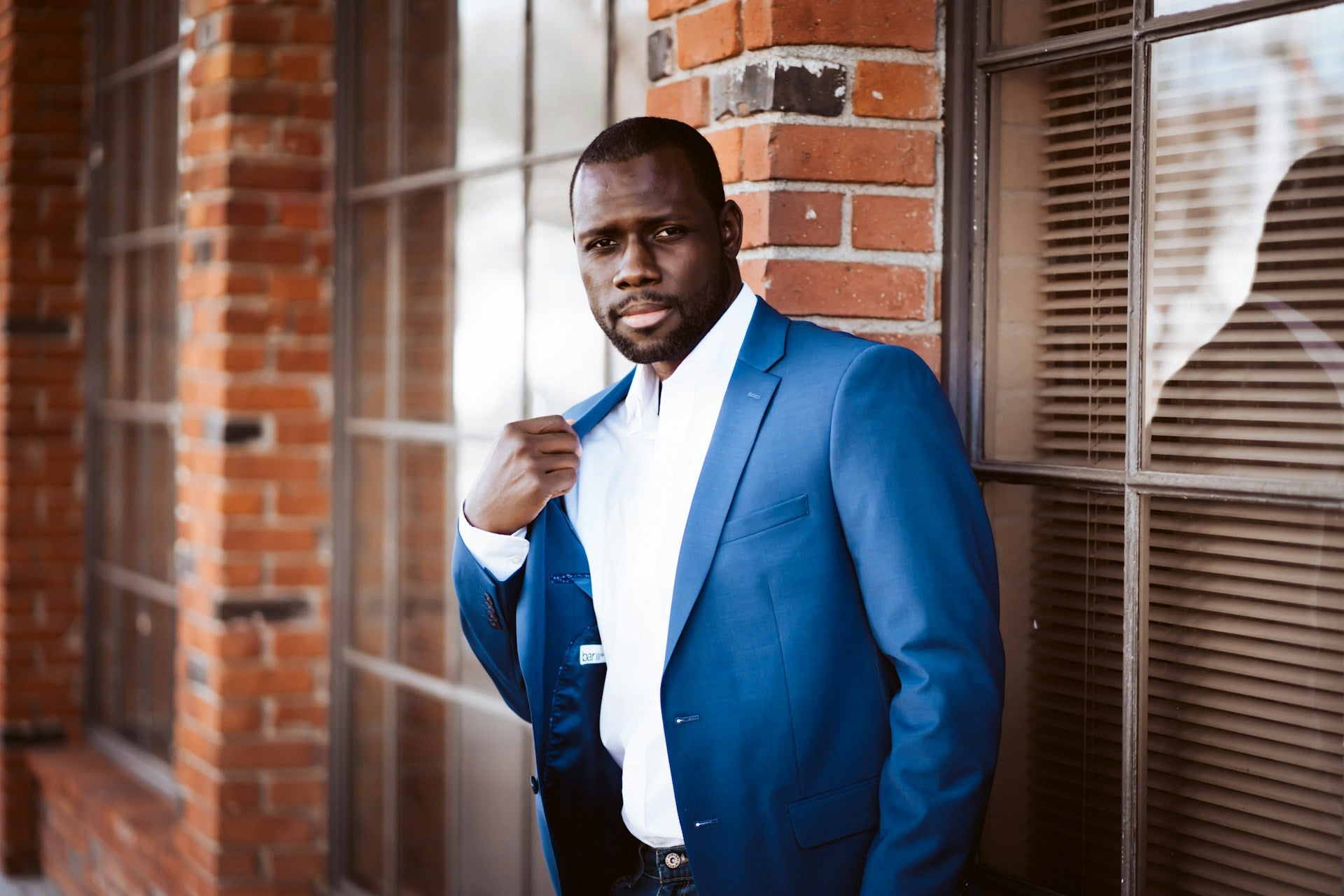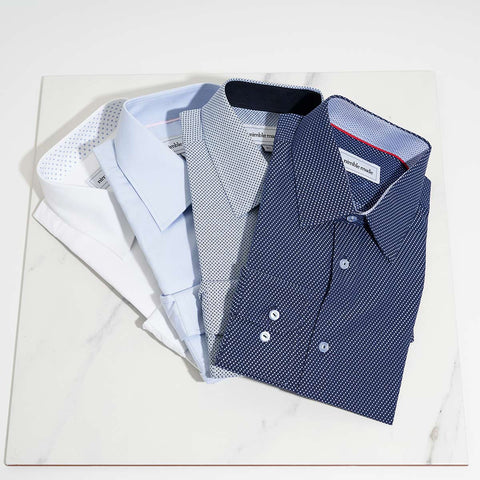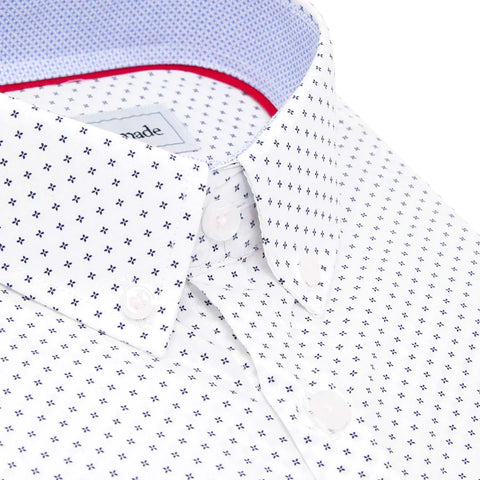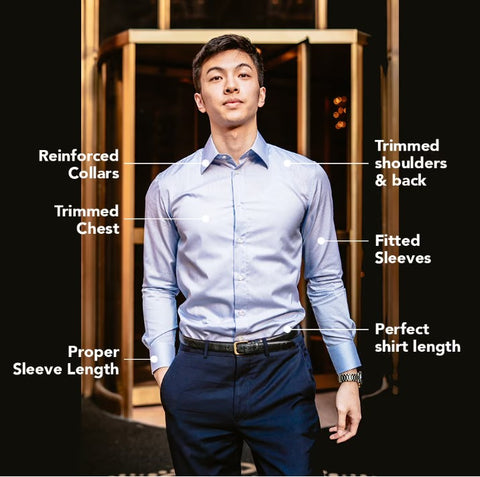
Written by Sonia Su
Wearing a suit without a tie exudes a refined yet relaxed charm. The absence of a tie creates a sleek and effortlessly chic silhouette, allowing the focus to shift to the tailored lines and details of the suit itself.
This ensemble strikes the perfect balance between sophistication and nonchalance, making it an ideal choice for various occasions, from semi-formal events to stylish evenings out.
Whether you're heading to the office, attending a casual event, or just looking to refresh your style, we'll guide you through occasions best suited for a tie-less look; suits you can wear without ties; choosing the right shirt from Nimble Made to pair with your suit; and tips and tricks to make your suit stand out, even without a tie. If you do decide to wear a tie, read our guide on what color tie with navy suit.When to Wear a Suit Without Tie
There are several occasions where you may opt for a tieless suit and instead try just a dress shirt and suit jacket.
- Weddings: In recent years, many weddings have embraced a more relaxed dress code, making a suit without a tie an acceptable choice, particularly for daytime or outdoor ceremonies.
- Cocktail Parties: For semi-formal events like cocktail parties or gallery openings, a suit without a tie strikes the perfect balance between elegance and ease, allowing you to look more attractive without being overdressed.
-
Business Casual Meetings: In professional settings where a strict dress code isn't enforced, such as business casual offices or client meetings, a well-fitted suit without a tie can convey professionalism while still feeling approachable.

- Dinner Receptions: Whether it's a formal dinner with colleagues or a celebratory reception, opting for a suit without a tie offers a polished yet relaxed look that's appropriate for evening festivities if you want to try looksmaxing.
- Date Nights: Impress your significant other with a sophisticated yet effortlessly stylish ensemble by wearing a suit without a tie for a romantic dinner date or a night out on the town.
-
Networking Events: When mingling with peers and potential clients at networking events or industry conferences, a suit without a tie can help you make a memorable impression without appearing overly formal.

- Fashionable Events: Attending fashion shows, art exhibits, or trendy social gatherings often calls for a fashion-forward approach. A suit without a tie allows you to showcase your personal style while still adhering to the event's sophistication.
-
Casual Celebrations: From milestone birthdays to holiday gatherings, wearing a suit without a tie adds a touch of refinement to casual celebrations without feeling overdressed.

There may be other occasions, including church missions in certain locations, where a tie may not be necessary.
Types of Suits Without Ties
Several types of suits lend themselves well to being worn without a tie, offering a stylish and relaxed aesthetic:
Linen Suits
Linen suits are lightweight and breathable, making them ideal for warm-weather occasions like outdoor weddings or beach parties where a tie may feel too formal and can be paired with a less formal shirt.
Casual Suit Blazers

Blazers in casual fabrics like cotton or tweed can be paired with dress trousers or chinos for a smart-casual look that doesn't require a tie. This ensemble is perfect for laid-back gatherings or weekend outings. Our favorite blazers for men here.
Slim-Fit Suits
Slim-fit suits often have a more contemporary silhouette and can be worn without a tie for a sleek and modern appearance—such as a black dress shirt beneath a grey suit. They're suitable for a variety of occasions, from business casual meetings to evening events. Browse Nimble Made's slim-fit dress shirts to match.
Patterned Suits
Suits with bold patterns or textures, such as checks, plaids, or herringbone, can make a statement on their own without the need for a tie. Pairing them with a crisp dress shirt and pocket square creates a polished yet distinctive look. Browse Nimble Made's checkered and gingham shirts to pair with these patterned suits.
Double-Breasted Suits
Double-breasted suits inherently convey a sense of formality, allowing them to be worn without a tie for occasions where a traditional suit-and-tie combination might feel too dressy. They add a touch of sophistication to any ensemble, and you can still pair it with a pocket square.

Dark-Washed Denim Suits
For a more casual yet stylish vibe, a dark-washed denim navy suit can be worn without a tie for informal gatherings or nights out. Paired with a well-fitted shirt, they offer a modern twist on classic tailoring.

Pairing Dress Shirts Without Ties
When it comes to styling dress shirts without ties, versatility and attention to detail are key. Opt for well-fitted shirts in classic colors like white, light blue, or pastel shades, which serve as the perfect canvas for various ensembles.
Check out Nimble Made's bestselling dress shirts, including this white dress shirt that has sold out over 8x and this blue dress shirt that features a modern herringbone weave.

For a polished look, consider buttoning the shirt up to the top and adding collar stays to maintain crispness. Alternatively, leaving the top button undone creates a more relaxed vibe. Experiment with different collar styles, such as spread, button-down, or point collars, to complement your face shape and suit lapel width.
For subtle patterns and designs, check out Nimble Made's White Collar Speckled Dress Shirt and Dark Navy Blue Textured Dress Shirt. Nimble Made also offers a White Patterned Button Down Dress Shirt and Light Blue Floral Dress Shirt.
Lastly, among other accessories, pay attention to cufflinks, opting for subtle designs or classic styles to add a touch of sophistication to your ensemble without overshadowing the shirt's elegance. Here are guides to wearing cufflinks and shirt cuffs. Consider a pocket square, such as this Gold Silk Pocket Square and Light Blue Pocket Square.

The Best Shirt Collars for an Open Look
When considering a stylish tieless suit, certain shirt collar styles excel in maintaining a balance between casual elegance and sharp sophistication:
-
Button-Down Collar: Known for its versatility, the button-down vs button-up collar offers a laid-back yet polished appearance when worn without a tie. The shirt collar points stay in place, framing the face neatly and providing a structured look that works well for both casual and smart-casual settings.

- Spread Collar: With wider collar points that angle outwards, the spread collar lends itself gracefully to being worn open. This collar style adds a touch of modern flair to your ensemble while maintaining a refined silhouette, making it a popular choice for dressier occasions.
- Cutaway Collar: The cutaway collar features wide-set points that create an open neckline, making it an excellent choice for showcasing a tieless look. Its distinctive shape offers a contemporary twist on traditional tailoring, adding visual interest to your outfit without overwhelming it.
- Mandarin Collar: For a sleek and minimalist aesthetic, consider opting for a mandarin collar shirt. Characterized by its stand-up collar without points, this collar style exudes sophistication and pairs effortlessly with jackets or blazers for a refined yet relaxed ensemble.
- Band Collar: Similar to the mandarin collar, the band collar lacks points and offers a clean, streamlined look when worn open. Its simplicity adds a touch of understated elegance to your outfit, making it a versatile option for various occasions.
Each of these shirt collar styles lends itself well to an open-collar look, allowing you to showcase your personal style with confidence and finesse. Browse Nimble Made's collared shirts.

Tips and Tricks to Wearing Suits Sans Tie
Choose a Statement Shirt
Opt for a dress shirt with subtle patterns, bold colors, or unique textures to add visual interest to your ensemble sans tie. Experiment with fabrics like chambray, denim, or patterned cotton to elevate your look.
Accessorize Thoughtfully
Incorporate pocket squares, fun dress socks, lapel pins, stylish watches, and other accessories to enhance your suit's appearance. Adding a patterned pocket square, for example, can be a great way to add style while staying casual. These small details can make a big impact and help you stand out in a crowd, even without a tie.

Experiment with Layering
Layering is a great way to add depth and dimension to your outfit. Consider wearing a waistcoat or a tailored vest over your dress shirt for a sophisticated yet relaxed look that sets you apart from the crowd.

Play with Textures and Fabrics
Mix and match different textures and fabrics to create visual contrast and depth. Pair a wool suit with a lightweight linen or cotton shirt for an interesting juxtaposition of materials that adds visual intrigue to your ensemble.

Focus on Fit and Tailoring
Ensure that your suit fits impeccably and is tailored to your body shape. A well-fitted suit not only looks more polished and professional but also allows you to exude confidence and sophistication, even without a tie.
Be sure to check out Nimble Made's fit guide, suit size calculator, and guides on how a suit jacket should fit, modern fit vs slim fit, and types of suits for men. Nimble Made also offers a collection of dress shirts for shorter men.
Experiment with Knotless Neckwear
Consider alternative neckwear options such as a silk scarf, an ascot, or a stylish neckerchief for a modern twist on traditional neckwear. These and other accessories can add a pop of color or pattern to your outfit and help you express your personal style.

Pay Attention to Grooming
Complete your look by paying attention to grooming details such as hairstyle, facial hair, and shoe choice. A well-groomed appearance enhances the overall impact of your outfit and ensures that you look put-together and stylish, even without a tie.
Check out our guide on undershirts, and shop Nimble Made's slim-fit T-shirts, including this v-neck T-shirt, which can be considered v-neck undershirt.
Conclusion
Frequently Asked Questions about Wearing a Suit without Tie
Is it OK to wear a suit without tie?
Yes, it's perfectly acceptable to wear a suit without a tie, especially in contemporary fashion where business casual attire is becoming more common. This can create a stylish and relaxed look, suitable for various occasions ranging from semi-formal events to everyday professional settings.
What is it called when you wear a suit with no tie?
Wearing a suit without a tie is often referred to as "going tieless" or adopting a "tieless look." This style choice can convey a more relaxed or modern aesthetic while still maintaining a polished appearance.
What kind of suit does not need a tie?
A casual suit, such as a linen or cotton suit, typically doesn't require a tie. These suits are often worn in more relaxed settings where a tie would be considered overdressed.
Is not wearing a tie unprofessional?
The professionalism of not wearing a tie largely depends on the context of your workplace or the event you're attending. In many modern and casual work environments, not wearing a tie is perfectly acceptable and even encouraged.
However, in more traditional or formal settings, such as corporate offices, formal events, or certain client meetings, wearing a tie may still be considered a standard part of professional attire.
Here are a few things to consider:
-
Company Culture: Every workplace has its own dress code. Check your company's dress code policy or observe the norms in your office to determine if a tie is expected.
-
Industry Standards: Different industries have varying expectations. For example, finance and law firms often adhere to more formal dress codes, while tech startups may have a more relaxed approach.
-
Occasion: For formal events, client meetings, or presentations, a tie might be more appropriate. When in doubt, it's better to err on the side of being slightly overdressed.
-
Personal Presentation: If you're unsure, consider opting for a smart, professional look that aligns with your company’s standards. In some cases, you can still maintain a polished appearance without a tie by focusing on well-fitted clothing and a neat appearance.
Ultimately, professionalism is about more than just attire—it's also about how you present yourself, your work ethic, and how you interact with others.






Comments (0)
Back to News